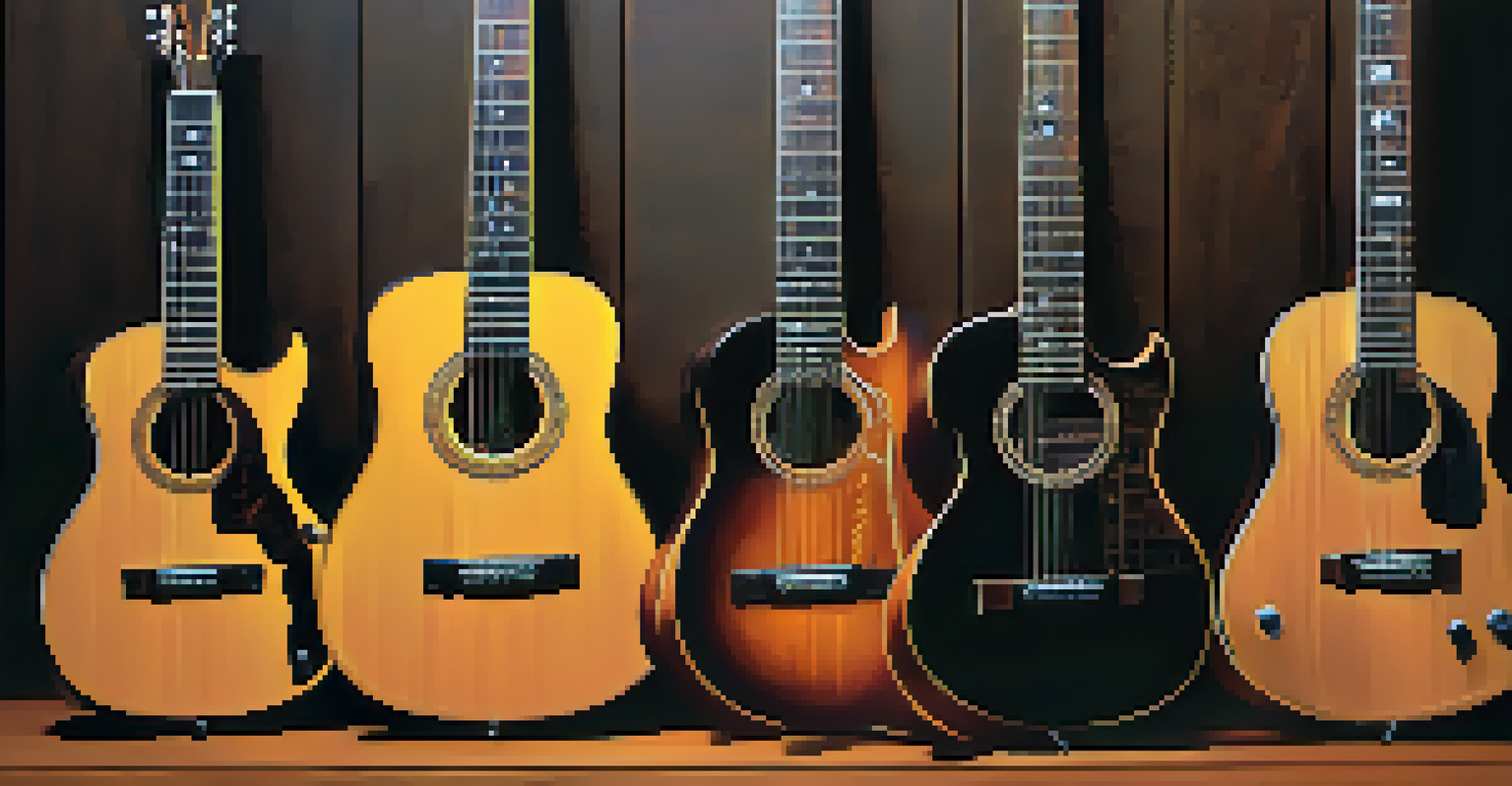Understanding Guitar Neck Profiles: Finding Your Perfect Fit

What Are Guitar Neck Profiles and Why Do They Matter?
Guitar neck profiles refer to the shape and dimensions of the neck, which can significantly affect your playing experience. Different profiles cater to various playing styles and hand sizes, making it crucial to find the right fit. Whether you prefer a chunky neck for a solid grip or a slimmer profile for faster playing, understanding these options can enhance your comfort and performance.
The guitar is a miniature orchestra in itself.
When you pick up a guitar, the neck is one of the first things you'll notice. Your grip on the neck influences your technique and agility, so a profile that feels right is essential. Just like a well-fitted pair of shoes, the right neck profile can help improve your overall playing experience.
In this article, we’ll explore various neck profiles, their unique characteristics, and how they can impact your playing style. By the end, you’ll have a clearer idea of what to look for in your next guitar.
Common Guitar Neck Profiles: A Quick Overview
Guitar neck profiles can generally be categorized into a few common shapes. The most popular profiles include C, U, and V shapes, each offering a different feel and level of comfort. For instance, a C shape is often rounded and suitable for a wide range of playing styles, while a U shape is thicker, catering to those who appreciate a more substantial grip.

V-shaped necks, on the other hand, provide a vintage feel and are favored by players who enjoy fingerstyle or blues. Understanding these profiles helps you make informed choices about your instrument, aligning it with your personal style and preferences.
Neck Profiles Affect Playing Comfort
Choosing the right guitar neck profile can significantly enhance your playing experience by providing the comfort and support you need.
Each of these profiles has its own strengths, and the best choice often comes down to personal comfort and playing technique. Experimenting with different shapes can reveal what feels most natural for you.
C Shape Neck Profile: Versatile and Comfortable
The C shape neck profile is one of the most popular options among guitarists, celebrated for its versatility. Its rounded design offers a comfortable grip that suits various playing styles, making it a go-to for many musicians. Whether you're strumming chords or playing intricate solos, the C shape can accommodate your needs.
Playing the guitar is like telling the world you're going to be okay.
Many electric guitars and acoustics feature this neck profile, making it widely accessible. Guitarists often find that the C shape promotes ease of movement and reduces hand fatigue, especially during long practice sessions. This is particularly beneficial for beginners who are still developing their technique.
If you're unsure about which neck profile to choose, starting with a C shape is a safe bet. Its balanced design allows for an enjoyable playing experience, letting you focus on honing your skills rather than struggling with discomfort.
U Shape Neck Profile: For Those Who Love Substance
The U shape neck profile is known for its thicker, more substantial feel, providing a sense of security for players who prefer a strong grip. This profile is often favored by guitarists who enjoy barre chords or heavy strumming, as it offers excellent support for the fingers. The additional mass can enhance sustain, making it a popular choice for rock and blues players.
While some players may initially find the U shape to be cumbersome, many grow to appreciate its unique characteristics. It can help with finger strength and control, allowing you to execute more demanding techniques with ease. However, it might not be ideal for those with smaller hands or those who prefer faster playing styles.
Common Neck Shapes Explained
Guitar neck profiles, such as C, U, and V shapes, each offer different feels that cater to various playing styles and preferences.
If you’re considering a U shape neck, it's worth trying out a few guitars to see how it feels in your hands. Finding the right balance between comfort and playability is essential, and the U shape can be a rewarding choice for the right player.
V Shape Neck Profile: The Vintage Appeal
The V shape neck profile offers a distinctive vintage vibe that appeals to many players, especially those who enjoy classic rock and blues. Its angular design allows for a unique grip that can feel more natural for some guitarists. This profile is often associated with older guitars, giving it an authentic feel that many musicians crave.
Playing a guitar with a V shape neck can lead to improved finger positioning, making it easier to navigate the fretboard. However, it may not be suitable for everyone, particularly those who find the sharp edges uncomfortable after extended playing. As with any neck profile, personal preference plays a huge role in its effectiveness.
If you're drawn to the sound and style of vintage guitars, trying out a V shape neck could be a great choice. Just be sure to assess how it feels in your hands to ensure it complements your playing style.
Finding Your Ideal Guitar Neck Profile: Tips and Tricks
Choosing the right neck profile can be a personal journey, and there are several factors to consider. Start by assessing your playing style and technique; for instance, fingerstyle players might benefit from a slimmer neck, while those who play heavy chords may prefer a thicker profile. It's essential to think about what feels comfortable and natural for you.
Visiting a local music store can be incredibly helpful. Spend time playing different guitars with various neck profiles to see what resonates with you. Don't hesitate to ask for assistance from store employees; they can offer valuable insights based on your preferences.
Materials Impact Neck Feel
The materials and construction of a guitar neck not only contribute to its sound but also influence how comfortable it feels in your hands.
Ultimately, take your time when selecting a guitar. It’s not just about the sound; the neck profile plays a crucial role in your overall experience. Finding the perfect fit can lead to hours of enjoyable practice and performance.
The Role of Material and Construction in Neck Profiles
While the shape of the neck is essential, the materials and construction methods also play a significant role in the overall feel and sound. Common materials include maple, mahogany, and rosewood, each contributing different tonal qualities and playability. The choice of wood can affect the weight and resonance of the neck, impacting your playing experience.
Additionally, the neck's construction—whether it's a bolt-on or set neck—can influence stability and maintenance. For example, a set neck typically offers better sustain and is often found on higher-end guitars, while bolt-on necks allow for easier replacements or adjustments. Understanding these factors can help you make a more informed decision.

When trying out guitars, pay attention to how the materials and construction feel in your hands. Finding a neck that combines the right profile with quality materials can elevate your playing and enjoyment.
Conclusion: Embrace Comfort and Style in Your Playing
In the world of guitars, comfort and style go hand-in-hand, and the neck profile is a significant piece of that puzzle. Exploring different profiles can lead to a more enjoyable playing experience, helping you express your musical ideas with ease. Remember, there's no one-size-fits-all solution—what works for one player may not suit another.
As you embark on this journey to find your perfect neck profile, keep an open mind and trust your instincts. Your ideal guitar is out there, waiting for you to discover it. By understanding the nuances of neck profiles, you're better equipped to make a choice that enhances your comfort and enhances your sound.
So, grab your favorite guitar and start experimenting! With the right neck profile, you'll unlock new levels of creativity and enjoyment in your musical journey.